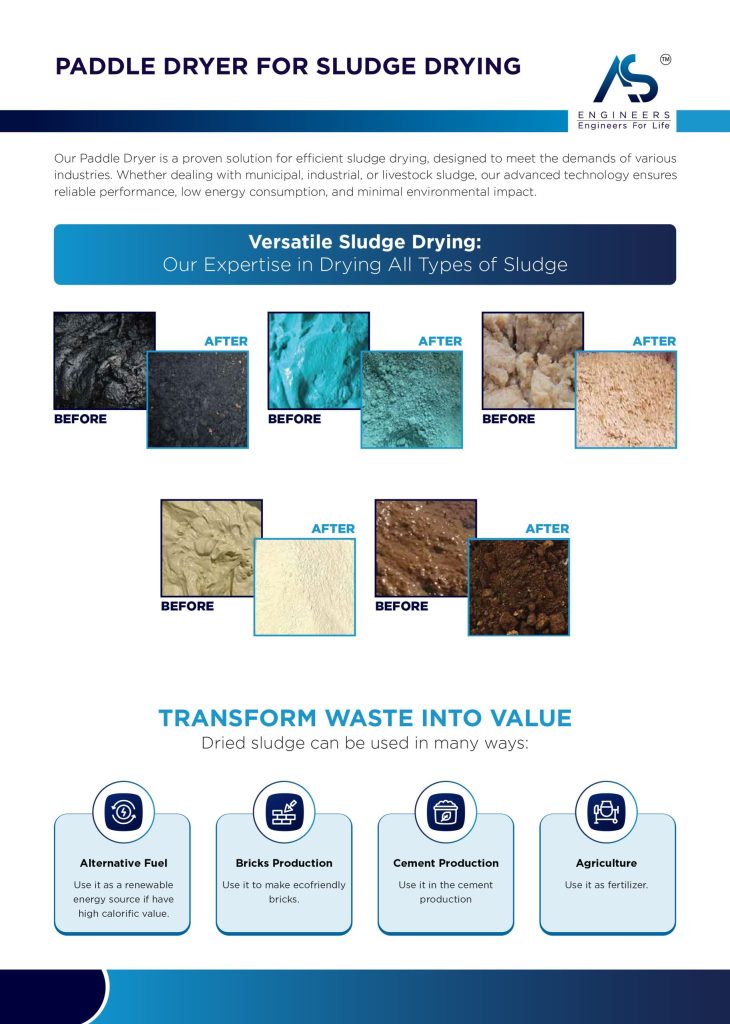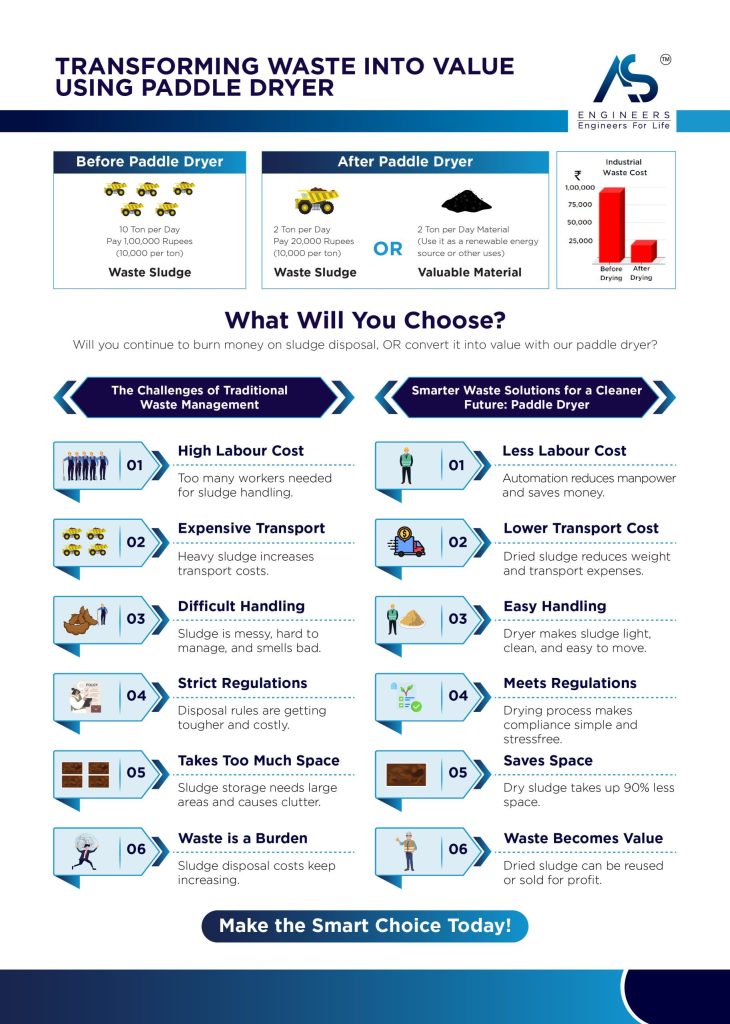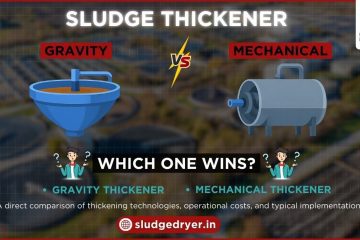Did you know that the global industrial coatings sector generates over 4 million tons of paint sludge annually? For manufacturing facilities and industrial painting operations, managing this hazardous byproduct represents one of the most challenging waste management hurdles they face. Paint sludge – the semi-solid residue resulting from industrial coating processes – demands specialized handling not just for environmental compliance, but for operational efficiency and cost control.
This comprehensive guide will walk you through everything you need to know about paint sludge management, from its unique characteristics to cutting-edge disposal solutions.
Table of contents
- What Exactly Is Paint Sludge and Why Is It So Problematic?
- Paint Sludge vs. Conventional Biosolids: Key Differences
- The Environmental Impact of Improper Paint Sludge Disposal
- Regulatory Framework Governing Paint Sludge Management
- Best Practices for Paint Sludge Handling and Storage
- Paint Sludge Disposal Options: Traditional and Innovative Approaches
- Innovative Recycling and Recovery Technologies
- Economic Considerations in Paint Sludge Management
- Minimizing Paint Sludge Generation: Source Reduction Strategies
- Case Studies: Successful Paint Sludge Management Programs
- Future Trends in Paint Sludge Management
- Developing a Comprehensive Paint Sludge Management Plan
- Conclusion: Building a Sustainable Approach to Paint Sludge
What Exactly Is Paint Sludge and Why Is It So Problematic?
Paint sludge is the thick, semi-solid waste material generated during industrial coating operations, particularly in paint booth systems. This complex mixture contains spent paint particles, solvents, water, and chemical treatment additives that settle out during the painting process or wastewater treatment. Unlike typical industrial waste streams, paint sludge presents unique challenges due to its composition.
The automotive industry alone generates approximately 40% of all industrial paint sludge, with each vehicle produced creating between 4-10 pounds of paint waste. Other major contributors include:
- Furniture manufacturing
- Metal fabrication facilities
- Aerospace component production
- Large equipment manufacturing
- Construction material coating
What makes paint sludge particularly problematic is its classification as hazardous waste in most jurisdictions. The presence of heavy metals (cadmium, chromium, lead), volatile organic compounds (VOCs), and other toxic substances means it falls under strict regulatory frameworks like the Resource Conservation and Recovery Act (RCRA) in the United States.
Composition of Industrial Paint Sludge
Understanding the typical composition of paint sludge is essential for proper management:
- Pigments and colorants: 15-30%
- Resins and binding agents: 25-40%
- Solvents: 10-20%
- Water: 15-25%
- Treatment chemicals: 5-10%
- Heavy metals: 0.5-5%
The exact composition varies significantly based on the industry, coating type, application method, and water treatment processes used. Powder coating operations produce different sludge characteristics than liquid paint applications, while water-based paint systems generate different waste streams than solvent-based operations.
Paint Sludge vs. Conventional Biosolids: Key Differences
Paint sludge differs substantially from conventional biosolids or wastewater treatment sludges in several critical ways that affect handling and disposal options:
Chemical Composition
While municipal biosolids primarily contain organic materials and nutrients that can be beneficial for agricultural applications, paint sludge contains synthetic polymers, solvents, and heavy metals that limit its beneficial reuse options. The hazardous components in paint sludge require specialized treatment approaches not necessary for conventional biosolids.
Treatment Requirements
Biosolids typically undergo biological treatment processes that break down organic matter, whereas paint sludge requires physical-chemical treatment methods like coagulation, flocculation, and dewatering. The presence of cross-linked polymers and inorganic compounds makes paint sludge resistant to conventional biological degradation.
Disposal Regulations
Paint sludge frequently triggers hazardous waste regulations that don’t apply to conventional biosolids. This classification brings stricter transportation requirements, more limited disposal options, and significantly higher management costs.
Reuse Potential
While properly treated biosolids have established beneficial uses in agriculture and land reclamation, paint sludge has traditionally had fewer recycling pathways. However, as we’ll explore later, innovative technologies are expanding the reuse potential for paint waste.
The Environmental Impact of Improper Pai9nt Sludge Disposal
Mismanagement of paint sludge can have severe environmental consequences that extend far beyond the immediate disposal site:
Soil Contamination
When improperly disposed of in landfills without adequate containment, heavy metals and persistent organic pollutants can leach into surrounding soil. These contaminants can persist for decades, affecting soil fertility and potentially entering the food chain through plant uptake.
Water Pollution
Perhaps the most concerning impact is the potential contamination of groundwater and surface water resources. Even small quantities of paint sludge can contaminate large volumes of water, with some components being toxic to aquatic life at concentrations as low as parts per billion.
Air Quality Issues
Volatile components in paint sludge can evaporate, contributing to air pollution and potential respiratory health issues in surrounding communities. Improper incineration without adequate emission controls can release toxic compounds including dioxins and furans.
Carbon Footprint Considerations
The environmental impact extends to climate considerations as well. Traditional disposal methods like landfilling or incineration contribute to greenhouse gas emissions directly through methane generation or indirectly through transportation and processing energy requirements.
A 2022 lifecycle assessment study found that advanced recycling of paint sludge could reduce the carbon footprint by 60-75% compared to landfill disposal, highlighting the climate benefits of improved management practices.


Regulatory Framework Governing Paint Sludge Management
Understanding the regulatory landscape is essential for any facility generating paint sludge. While specific requirements vary by country and even among local jurisdictions, several common principles apply globally:
United States Regulations
In the U.S., paint sludge management falls primarily under:
- Resource Conservation and Recovery Act (RCRA): Governs hazardous waste identification, transportation, treatment, and disposal
- Clean Water Act: Regulates discharge of paint manufacturing and application wastewater
- Clean Air Act: Controls emissions from paint application and waste treatment facilities
- Toxic Substances Control Act (TSCA): Regulates specific chemical components in paint formulations
Most paint sludge requires testing through the Toxicity Characteristic Leaching Procedure (TCLP) to determine if it exceeds regulatory thresholds for metals like chromium, lead, or cadmium, or for organic compounds like benzene or toluene.
European Union Approach
The EU has implemented:
- Waste Framework Directive: Establishes the waste hierarchy prioritizing prevention and recycling
- Industrial Emissions Directive: Controls pollution from industrial painting operations
- Registration, Evaluation, Authorization and Restriction of Chemicals (REACH): Regulates chemicals used in paint formulations
- Landfill Directive: Places restrictions on landfilling of hazardous wastes like paint sludge
The EU’s circular economy initiatives have specifically targeted paint waste, with mandates for increasing recycling rates and producer responsibility programs.
Emerging Global Standards
Developing nations are increasingly adopting stricter paint sludge regulations, often modeled after U.S. or EU approaches but adapted to local conditions. International agreements like the Basel Convention control transboundary movements of hazardous wastes including paint sludge.
Best Practices for Paint Sludge Handling and Storage
Before disposal, proper handling and storage are crucial to prevent environmental contamination and ensure worker safety:
Collection Systems
Effective collection begins at the source with properly designed paint booth systems:
- Water curtain booths should incorporate efficient filtration systems
- Dry filter booths require regular filter changes and proper disposal
- Robotic application systems should be calibrated to minimize overspray
- Designated collection areas should be established for all paint-related waste
Containment Requirements
Paint sludge must be stored in compatible containers that:
- Are constructed of materials resistant to chemical degradation
- Feature secure, leak-proof sealing mechanisms
- Include secondary containment for spill prevention
- Are properly labeled with hazardous waste information
- Remain covered to prevent rainwater infiltration and volatilization
Transportation Considerations
When moving paint sludge either on-site or to off-site treatment facilities:
- Use approved DOT containers for hazardous waste
- Maintain proper shipping documentation including manifests
- Ensure vehicles are properly placarded
- Develop spill response procedures for transport incidents
- Use licensed hazardous waste transporters
Worker Safety Protocols
Employees handling paint sludge should follow strict safety procedures:
- Wear appropriate personal protective equipment (PPE)
- Receive training on hazard communication and safe handling
- Follow established decontamination procedures
- Understand emergency response protocols
- Participate in medical monitoring when appropriate
Paint Sludge Disposal Options: Traditional and Innovative Approaches
Managing paint sludge effectively requires understanding the full spectrum of disposal options, from conventional approaches to emerging technologies:
Landfill Disposal
While historically common, landfilling is increasingly restricted due to environmental concerns and rising costs:
- Hazardous waste landfills: Required for sludge failing TCLP tests
- Stabilization/solidification: Mixing with cement or other binders to reduce leaching potential
- Secure landfill cells: Specialized containment areas with additional monitoring
- Leachate collection systems: Required to capture and treat any liquid seepage
The average cost for hazardous waste landfill disposal ranges from $200-450 per ton, not including transportation and administrative expenses, making this one of the costliest options.
Incineration and Thermal Treatment
Thermal destruction methods leverage the energy content in paint sludge:
- Rotary kiln incinerators: Operate at 1800-2200°F to destroy organic components
- Cement kilns: Use paint sludge as an alternative fuel in cement manufacturing
- Pyrolysis systems: Thermal decomposition in the absence of oxygen
- Plasma arc technology: Extreme temperatures that vitrify inorganic components
These approaches can reduce volume by 90-95% but require sophisticated air pollution control systems to prevent emissions of heavy metals and products of incomplete combustion.
Chemical Treatment
Various chemical processes can detoxify or stabilize paint sludge components:
- Oxidation processes: Break down organic contaminants
- Neutralization: Adjusts pH to reduce corrosivity
- Precipitation: Removes dissolved metals as insoluble compounds
- Dehalogenation: Removes chlorinated compounds
These treatments typically serve as pre-processing steps rather than complete solutions, reducing hazardous characteristics before final disposal.
Biological Treatment Options
Though challenging due to the synthetic nature of many paint components, biological approaches show promise:
- Bioremediation: Using specialized microorganisms to break down organic components
- Composting: Mixing with organic materials to support biological degradation
- Landfarming: Controlled application to soil where natural processes aid breakdown
- Bioslurry reactors: Aerobic degradation in liquid suspension
These methods work best with water-based paint sludges that contain fewer toxic components and more biodegradable constituents.
Innovative Recycling and Recovery Technologies
The most exciting developments in paint sludge management involve recycling and material recovery:
Energy Recovery
Paint sludge contains significant energy value that can be harnessed:
- Waste-to-energy facilities: Dedicated plants that generate electricity from waste combustion
- Industrial boilers: Modified to accept paint sludge as supplemental fuel
- Gasification: Converting paint sludge into synthesis gas for energy production
- Refuse-derived fuel: Processing paint sludge into standardized fuel products
With heating values ranging from 5,000-12,000 BTU/lb depending on composition, paint sludge can significantly offset fossil fuel consumption.
Material Recovery and Reuse
Several technologies can recover valuable components from paint sludge:
- Solvent recovery: Extracting and purifying solvents for reuse
- Pigment reclamation: Recovering titanium dioxide and other valuable pigments
- Polymer recycling: Converting resin components into new products
- Metal reclamation: Extracting heavy metals for industrial applications
A Michigan-based company has pioneered a process that recovers up to 50% of paint sludge components for beneficial reuse, significantly reducing disposal volumes.
Incorporation Into Building Materials
One of the most successful recycling approaches involves using processed paint sludge in construction applications:
- Cement manufacturing: As both raw material and fuel substitute
- Concrete additives: Enhancing certain concrete properties
- Asphalt production: Partial replacement for traditional fillers
- Brick and ceramic products: Incorporating into structural materials
Research has demonstrated that properly treated paint sludge can replace up to 15% of traditional materials in certain construction applications without compromising performance.
Economic Considerations in Paint Sludge Management
The financial aspects of paint sludge management extend far beyond direct disposal costs:
True Cost Calculation
A comprehensive analysis considers:
- Direct disposal or treatment fees
- Transportation and handling expenses
- Regulatory compliance costs (permitting, reporting, testing)
- Liability insurance and financial assurance requirements
- Labor costs for waste handling and management
- Potential future remediation liabilities
When all factors are included, costs can range from $300-1,200 per ton depending on sludge characteristics and management method.
Return on Investment for Advanced Technologies
While innovative treatment technologies often require higher upfront investment, they can deliver significant long-term savings:
- Reduced disposal volumes translating to lower tipping fees
- Decreased transportation requirements
- Recovery of valuable materials
- Potential energy generation
- Reduced environmental liability
A case study from an automotive manufacturing facility showed that implementing an advanced paint sludge recycling system with a $1.2 million capital cost achieved payback within 3.5 years through disposal cost avoidance.
Financial Incentives and Support Programs
Various mechanisms can improve the economics of paint sludge management:
- Tax credits for implementing recycling technologies
- Grant programs for pollution prevention projects
- Low-interest loans for environmental equipment
- Accelerated depreciation for pollution control assets
- Carbon offset credits for documented emissions reductions
Businesses should investigate both government programs and private sector opportunities when evaluating investment decisions.
Minimizing Paint Sludge Generation: Source Reduction Strategies
The most effective waste management strategy is to reduce generation at the source:
Process Optimization
Operational improvements can significantly reduce waste:
- Transfer efficiency improvement: Upgrading to high-efficiency applicators like HVLP guns
- Advanced spray technologies: Robotic systems with precision application
- Electrostatic systems: Enhancing paint particle attraction to the target surface
- Color sequencing: Minimizing color change waste
- Booth maintenance optimization: Reducing unnecessary cleaning cycles
Implementing best practices can reduce paint waste by 25-40% in many operations.
Paint Formulation Modifications
Changing the coatings themselves offers another approach:
- High-solids formulations: Reducing solvent content
- Water-based alternatives: Eliminating hazardous solvents
- Powder coating conversion: Eliminating liquid waste streams
- UV-curable coatings: Reducing energy requirements and waste
- Smart coatings: Self-healing or multi-functional coatings that extend service life
Modern coating technologies not only reduce waste but often improve performance and durability.
Paint Booth Design Innovations
Physical infrastructure improvements support waste reduction:
- Water-conserving booth designs: Reducing wastewater volume
- Dry separation systems: Eliminating water from the waste stream
- Integrated filtration technology: Extending media life
- Heat recovery systems: Improving energy efficiency
- Modular designs: Facilitating maintenance and cleaning
New paint booth systems can achieve up to 98% transfer efficiency compared to 60-70% for conventional designs.
Case Studies: Successful Paint Sludge Management Programs
Learning from industry leaders provides valuable insights into practical implementation:
Automotive Industry Solutions
A major U.S. auto manufacturer implemented a comprehensive paint sludge recycling program that:
- Reduced landfill disposal by 84%
- Recovered approximately 30% of paint solids for reuse
- Decreased hazardous waste management costs by $3.2 million annually
- Created a closed-loop system for certain paint components
The key to success was integrating waste reduction into the overall manufacturing strategy rather than treating it as a separate environmental initiative.
Small Business Approaches
A medium-sized metal fabrication company with limited resources:
- Formed a waste exchange partnership with a cement manufacturer
- Implemented simple dewatering technology to reduce volume
- Negotiated reduced disposal rates through waste consolidation
- Trained operators on waste minimization techniques
These straightforward approaches reduced their paint sludge management costs by 46% without major capital investment.
International Best Practices
A European industrial coatings operation developed an innovative approach:
- Installed on-site solvent recovery equipment
- Implemented a paint sludge dryer to reduce water content
- Configured their waste as an alternative fuel for a nearby industrial facility
- Created a by-product synergy network with complementary industries
Their integrated approach effectively transformed a waste liability into a resource, achieving near-zero waste to landfill status.
Future Trends in Paint Sludge Management
The field continues to evolve rapidly with several promising developments on the horizon:
Emerging Technologies
Watch for these innovations to reach commercial scale:
- Supercritical water oxidation: Using water’s unique properties at high temperature and pressure to break down organic constituents
- Sonochemical treatment: Applying ultrasonic energy to enhance chemical degradation
- Electrocoagulation: Using electrical current to remove contaminants more efficiently
- Microbial fuel cells: Generating electricity directly from paint sludge degradation
- Advanced membrane filtration: Separating components at the molecular level
These technologies promise to further reduce environmental impact while improving resource recovery.
Regulatory Direction
Regulatory trends will drive future management approaches:
- Increasingly stringent landfill restrictions
- Expanded producer responsibility requirements
- Mandatory recycling targets for industrial wastes
- Carbon pricing mechanisms affecting disposal economics
- Chemical-specific bans affecting paint formulations
Forward-thinking companies are already preparing for a regulatory landscape that will make traditional disposal increasingly difficult and expensive.
Industry Initiatives
Collaborative approaches are gaining momentum:
- Paint take-back programs expanding to industrial coatings
- Industry consortia developing shared treatment facilities
- Supply chain partnerships addressing waste throughout the lifecycle
- Digital tracking systems improving waste management transparency
- Certification programs recognizing sustainable waste management
These voluntary initiatives often move faster than regulatory requirements and can create competitive advantages for early adopters.
Developing a Comprehensive Paint Sludge Management Plan
Creating an effective management strategy requires a systematic approach:
Assessment Phase
Begin with a thorough evaluation:
- Waste characterization: Detailed analysis of sludge composition
- Volume quantification: Accurate measurement of generation rates
- Current cost analysis: Comprehensive accounting of all related expenses
- Regulatory compliance review: Identifying applicable requirements
- Technology screening: Evaluating potential management options
This foundation ensures decisions are based on facility-specific conditions rather than general assumptions.
Implementation Strategy
Develop a phased approach:
- Immediate improvements: Low-cost operational changes
- Short-term investments: Equipment modifications with quick payback
- Strategic initiatives: Longer-term technology investments
- Continuous improvement: Ongoing optimization and refinement
- Contingency planning: Backup options for system disruptions
This structured implementation makes progress achievable even with budget constraints.
Performance Monitoring
Track effectiveness through:
- Key performance indicators: Volume reduction, cost savings, compliance metrics
- Regular auditing: Independent verification of program effectiveness
- Benchmarking: Comparison with industry standards and best practices
- Employee feedback: Input from those implementing the program daily
- Stakeholder communication: Sharing progress with regulators, community, and customers
Monitoring provides accountability and identifies opportunities for further improvement.
Conclusion: Building a Sustainable Approach to Paint Sludge
Paint sludge management represents both a significant challenge and an opportunity for industrial coating operations. By implementing best practices, exploring innovative technologies, and taking a systematic approach to waste reduction, facilities can transform this problematic waste stream from an environmental liability into a potential resource.
The most successful programs share common elements: they integrate waste management into core business operations rather than treating it as a separate environmental concern; they continuously evaluate new technologies and approaches; and they recognize that investments in improved paint sludge management deliver returns through cost savings, reduced liability, and enhanced sustainability credentials.
As regulatory requirements become more stringent and stakeholders increasingly demand environmental responsibility, proactive paint sludge management will distinguish industry leaders from those struggling to adapt. The technologies and approaches outlined in this guide provide a roadmap for that journey toward more sustainable industrial coating operations.




